Marketing Fundamentals Report: Coca-Cola Amatil Target Market Analysis
VerifiedAdded on 2020/04/13
|11
|2221
|54
Report
AI Summary
This report provides a comprehensive analysis of Coca-Cola Amatil's marketing strategies. It begins with an overview of the company, its recent financial performance, and its focus on Coca-Cola sales. The report then delves into target market analysis, identifying children aged 8-17 in urban areas as the primary demographic and considering competitive pressures from PepsiCo and Nudie. The positioning strategy is outlined, emphasizing Coca-Cola's taste and flavor for children. The marketing mix variables are then examined in detail, including product mix (core, actual, and augmented product, brand strategy), pricing (competition-based and price adjustment), placement (distribution channels and coverage), and promotion (advertising, personal selling, sales promotion, PR, direct, and digital marketing). Extended marketing mix variables such as people, process, and physical evidence are also discussed. The report concludes that effective application of the marketing mix is crucial for Coca-Cola Amatil's success, especially in the competitive Australian market.
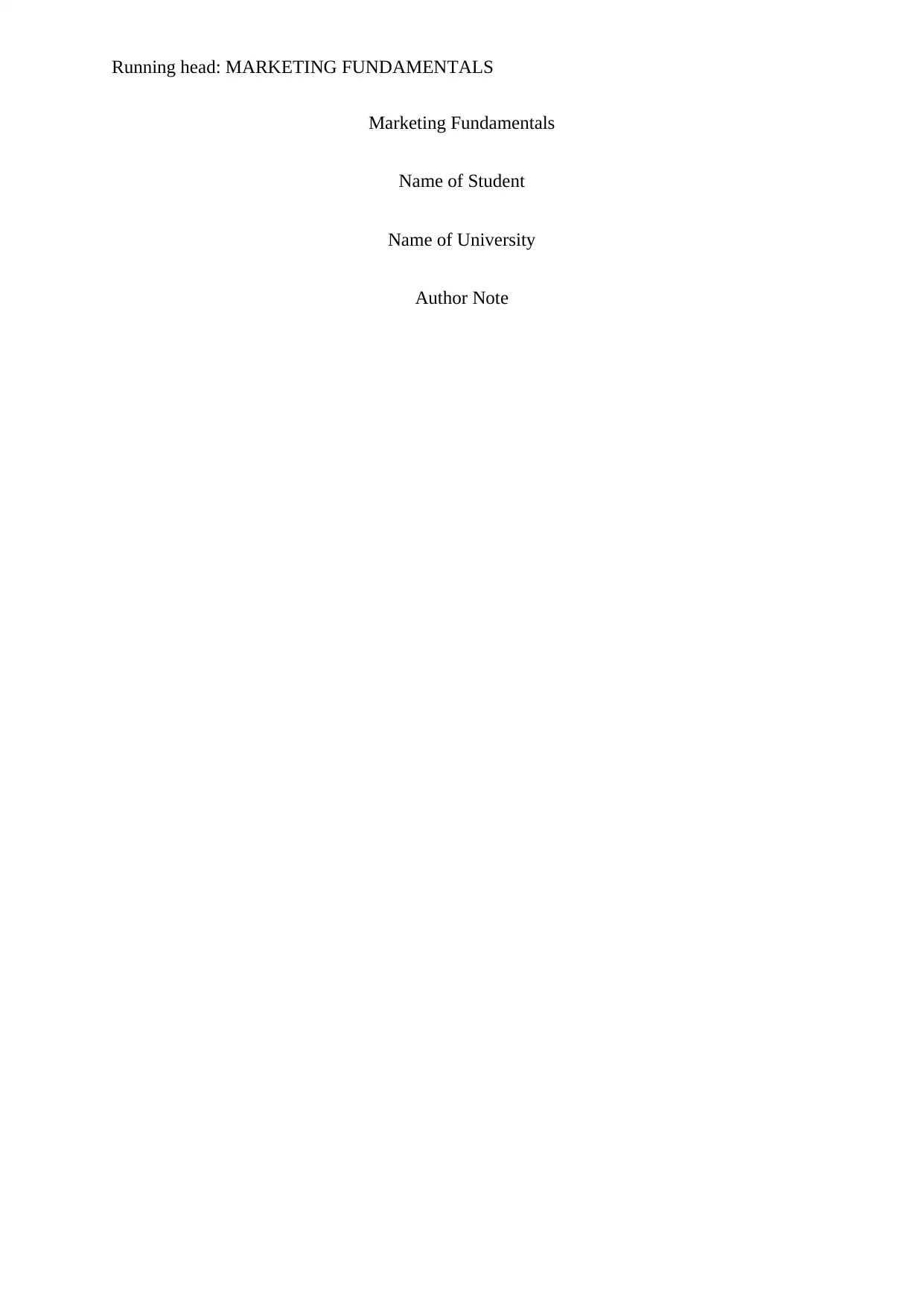
Running head: MARKETING FUNDAMENTALS
Marketing Fundamentals
Name of Student
Name of University
Author Note
Marketing Fundamentals
Name of Student
Name of University
Author Note
Paraphrase This Document
Need a fresh take? Get an instant paraphrase of this document with our AI Paraphraser
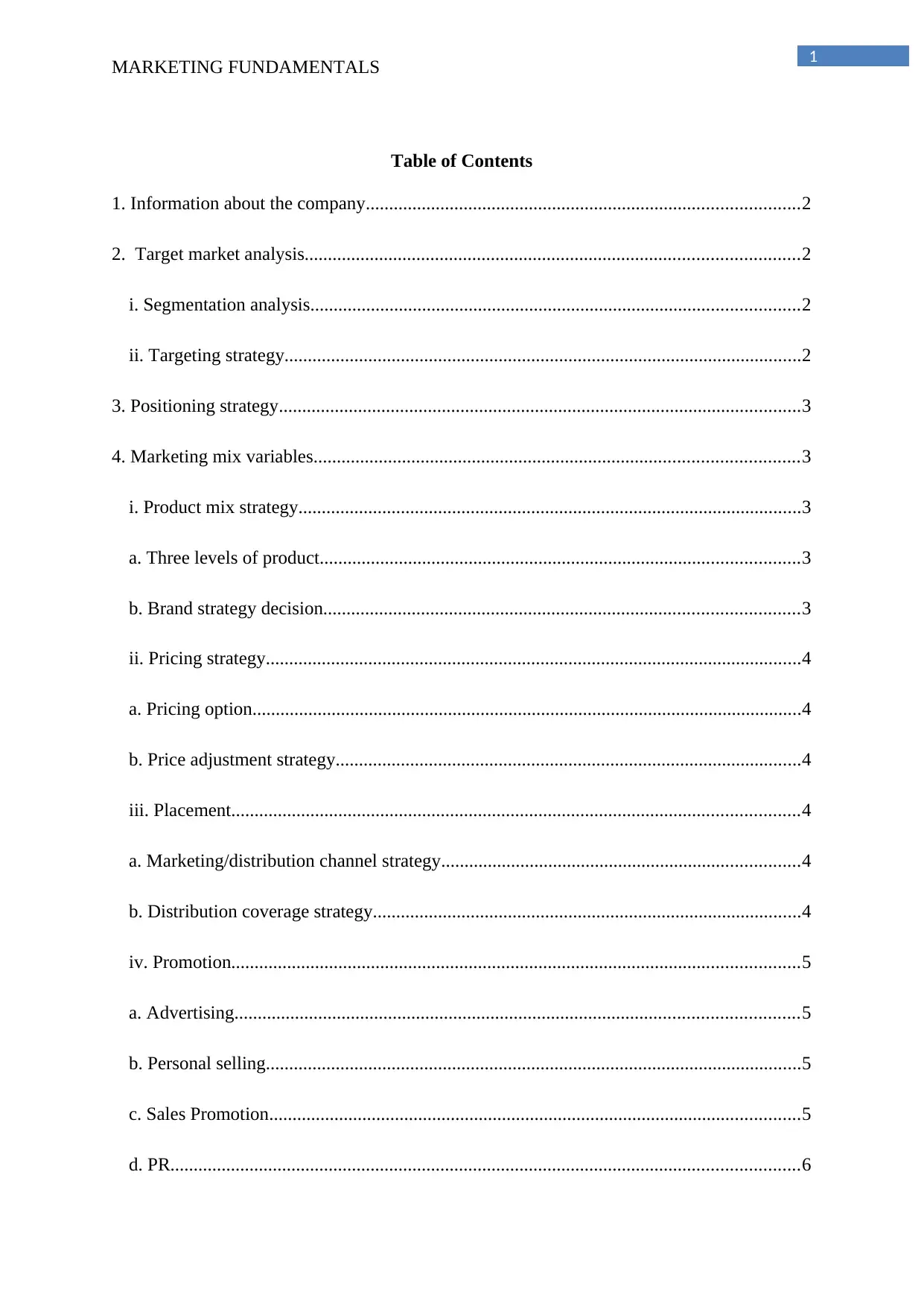
1
MARKETING FUNDAMENTALS
Table of Contents
1. Information about the company.............................................................................................2
2. Target market analysis..........................................................................................................2
i. Segmentation analysis.........................................................................................................2
ii. Targeting strategy...............................................................................................................2
3. Positioning strategy................................................................................................................3
4. Marketing mix variables........................................................................................................3
i. Product mix strategy............................................................................................................3
a. Three levels of product.......................................................................................................3
b. Brand strategy decision......................................................................................................3
ii. Pricing strategy...................................................................................................................4
a. Pricing option......................................................................................................................4
b. Price adjustment strategy....................................................................................................4
iii. Placement..........................................................................................................................4
a. Marketing/distribution channel strategy.............................................................................4
b. Distribution coverage strategy............................................................................................4
iv. Promotion..........................................................................................................................5
a. Advertising.........................................................................................................................5
b. Personal selling...................................................................................................................5
c. Sales Promotion..................................................................................................................5
d. PR.......................................................................................................................................6
MARKETING FUNDAMENTALS
Table of Contents
1. Information about the company.............................................................................................2
2. Target market analysis..........................................................................................................2
i. Segmentation analysis.........................................................................................................2
ii. Targeting strategy...............................................................................................................2
3. Positioning strategy................................................................................................................3
4. Marketing mix variables........................................................................................................3
i. Product mix strategy............................................................................................................3
a. Three levels of product.......................................................................................................3
b. Brand strategy decision......................................................................................................3
ii. Pricing strategy...................................................................................................................4
a. Pricing option......................................................................................................................4
b. Price adjustment strategy....................................................................................................4
iii. Placement..........................................................................................................................4
a. Marketing/distribution channel strategy.............................................................................4
b. Distribution coverage strategy............................................................................................4
iv. Promotion..........................................................................................................................5
a. Advertising.........................................................................................................................5
b. Personal selling...................................................................................................................5
c. Sales Promotion..................................................................................................................5
d. PR.......................................................................................................................................6
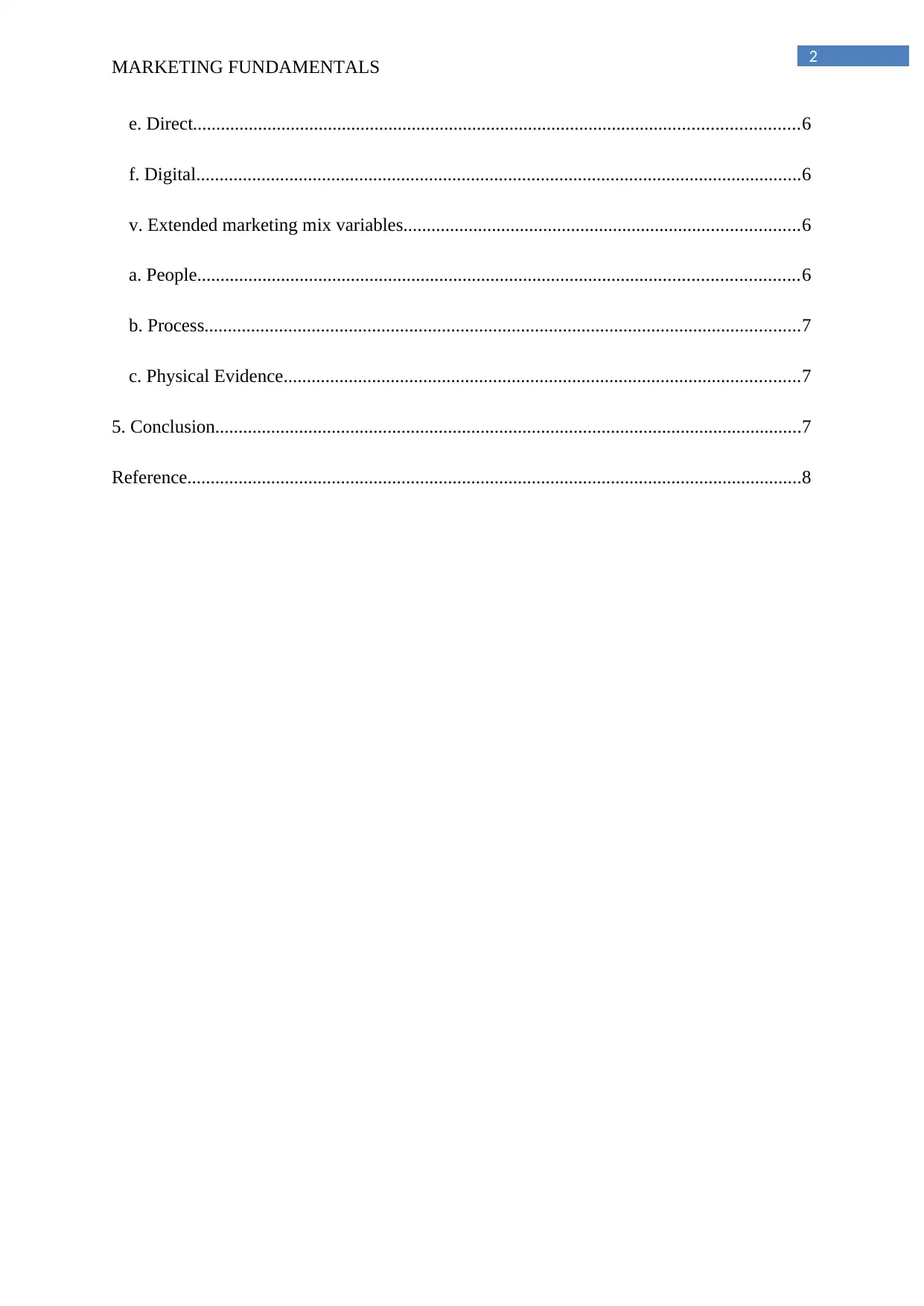
2
MARKETING FUNDAMENTALS
e. Direct..................................................................................................................................6
f. Digital..................................................................................................................................6
v. Extended marketing mix variables.....................................................................................6
a. People.................................................................................................................................6
b. Process................................................................................................................................7
c. Physical Evidence...............................................................................................................7
5. Conclusion..............................................................................................................................7
Reference....................................................................................................................................8
MARKETING FUNDAMENTALS
e. Direct..................................................................................................................................6
f. Digital..................................................................................................................................6
v. Extended marketing mix variables.....................................................................................6
a. People.................................................................................................................................6
b. Process................................................................................................................................7
c. Physical Evidence...............................................................................................................7
5. Conclusion..............................................................................................................................7
Reference....................................................................................................................................8
⊘ This is a preview!⊘
Do you want full access?
Subscribe today to unlock all pages.

Trusted by 1+ million students worldwide
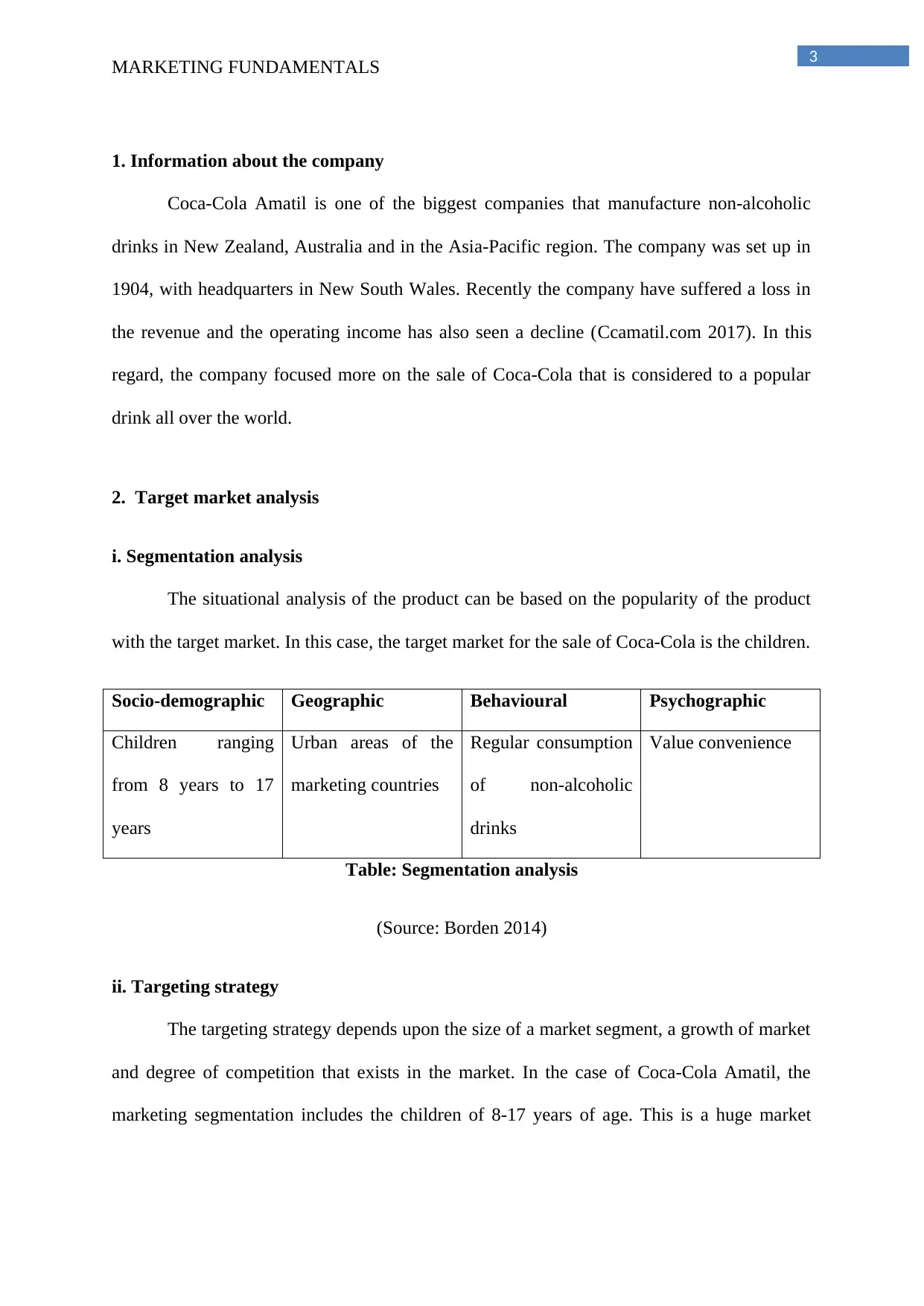
3
MARKETING FUNDAMENTALS
1. Information about the company
Coca-Cola Amatil is one of the biggest companies that manufacture non-alcoholic
drinks in New Zealand, Australia and in the Asia-Pacific region. The company was set up in
1904, with headquarters in New South Wales. Recently the company have suffered a loss in
the revenue and the operating income has also seen a decline (Ccamatil.com 2017). In this
regard, the company focused more on the sale of Coca-Cola that is considered to a popular
drink all over the world.
2. Target market analysis
i. Segmentation analysis
The situational analysis of the product can be based on the popularity of the product
with the target market. In this case, the target market for the sale of Coca-Cola is the children.
Socio-demographic Geographic Behavioural Psychographic
Children ranging
from 8 years to 17
years
Urban areas of the
marketing countries
Regular consumption
of non-alcoholic
drinks
Value convenience
Table: Segmentation analysis
(Source: Borden 2014)
ii. Targeting strategy
The targeting strategy depends upon the size of a market segment, a growth of market
and degree of competition that exists in the market. In the case of Coca-Cola Amatil, the
marketing segmentation includes the children of 8-17 years of age. This is a huge market
MARKETING FUNDAMENTALS
1. Information about the company
Coca-Cola Amatil is one of the biggest companies that manufacture non-alcoholic
drinks in New Zealand, Australia and in the Asia-Pacific region. The company was set up in
1904, with headquarters in New South Wales. Recently the company have suffered a loss in
the revenue and the operating income has also seen a decline (Ccamatil.com 2017). In this
regard, the company focused more on the sale of Coca-Cola that is considered to a popular
drink all over the world.
2. Target market analysis
i. Segmentation analysis
The situational analysis of the product can be based on the popularity of the product
with the target market. In this case, the target market for the sale of Coca-Cola is the children.
Socio-demographic Geographic Behavioural Psychographic
Children ranging
from 8 years to 17
years
Urban areas of the
marketing countries
Regular consumption
of non-alcoholic
drinks
Value convenience
Table: Segmentation analysis
(Source: Borden 2014)
ii. Targeting strategy
The targeting strategy depends upon the size of a market segment, a growth of market
and degree of competition that exists in the market. In the case of Coca-Cola Amatil, the
marketing segmentation includes the children of 8-17 years of age. This is a huge market
Paraphrase This Document
Need a fresh take? Get an instant paraphrase of this document with our AI Paraphraser
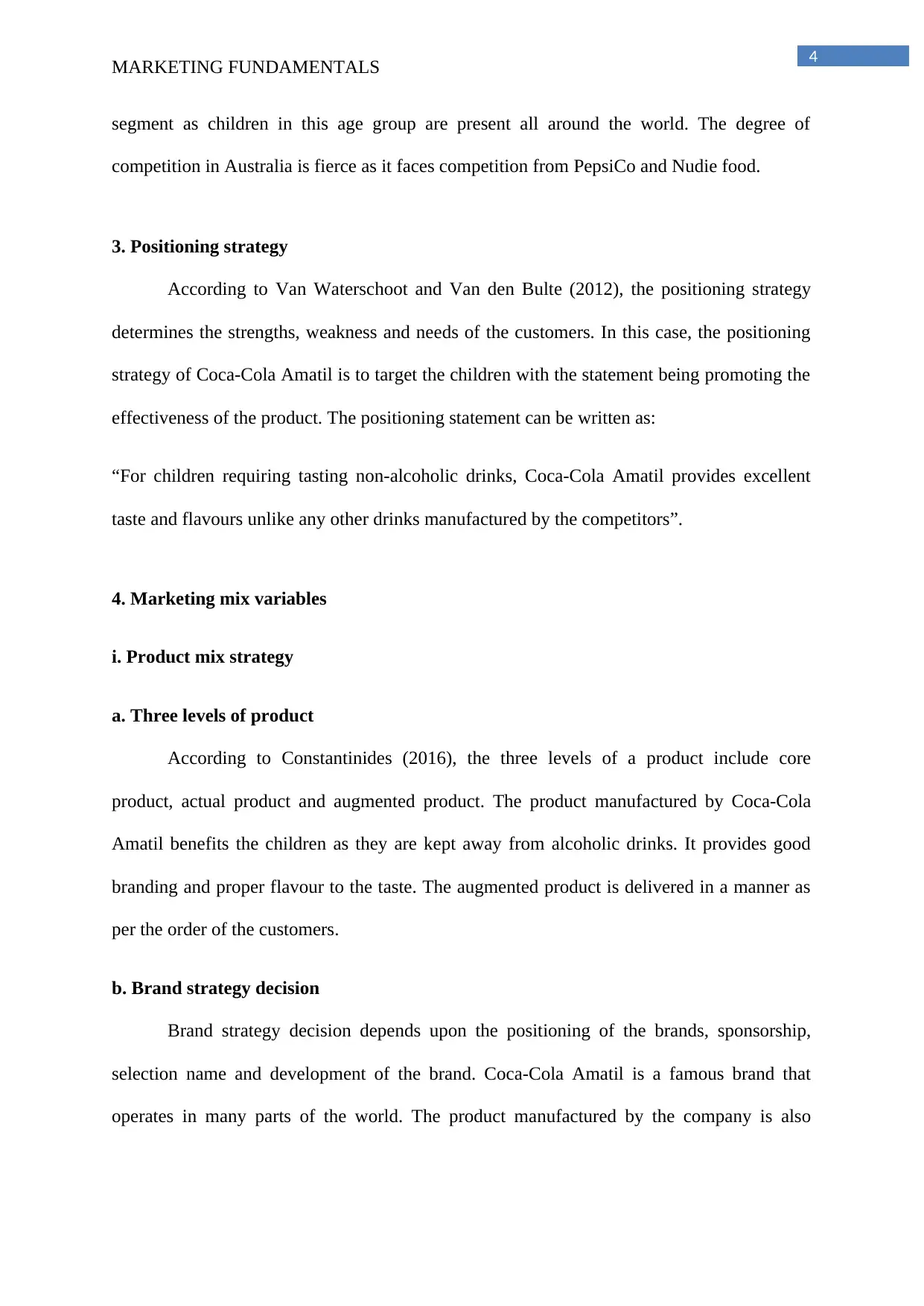
4
MARKETING FUNDAMENTALS
segment as children in this age group are present all around the world. The degree of
competition in Australia is fierce as it faces competition from PepsiCo and Nudie food.
3. Positioning strategy
According to Van Waterschoot and Van den Bulte (2012), the positioning strategy
determines the strengths, weakness and needs of the customers. In this case, the positioning
strategy of Coca-Cola Amatil is to target the children with the statement being promoting the
effectiveness of the product. The positioning statement can be written as:
“For children requiring tasting non-alcoholic drinks, Coca-Cola Amatil provides excellent
taste and flavours unlike any other drinks manufactured by the competitors”.
4. Marketing mix variables
i. Product mix strategy
a. Three levels of product
According to Constantinides (2016), the three levels of a product include core
product, actual product and augmented product. The product manufactured by Coca-Cola
Amatil benefits the children as they are kept away from alcoholic drinks. It provides good
branding and proper flavour to the taste. The augmented product is delivered in a manner as
per the order of the customers.
b. Brand strategy decision
Brand strategy decision depends upon the positioning of the brands, sponsorship,
selection name and development of the brand. Coca-Cola Amatil is a famous brand that
operates in many parts of the world. The product manufactured by the company is also
MARKETING FUNDAMENTALS
segment as children in this age group are present all around the world. The degree of
competition in Australia is fierce as it faces competition from PepsiCo and Nudie food.
3. Positioning strategy
According to Van Waterschoot and Van den Bulte (2012), the positioning strategy
determines the strengths, weakness and needs of the customers. In this case, the positioning
strategy of Coca-Cola Amatil is to target the children with the statement being promoting the
effectiveness of the product. The positioning statement can be written as:
“For children requiring tasting non-alcoholic drinks, Coca-Cola Amatil provides excellent
taste and flavours unlike any other drinks manufactured by the competitors”.
4. Marketing mix variables
i. Product mix strategy
a. Three levels of product
According to Constantinides (2016), the three levels of a product include core
product, actual product and augmented product. The product manufactured by Coca-Cola
Amatil benefits the children as they are kept away from alcoholic drinks. It provides good
branding and proper flavour to the taste. The augmented product is delivered in a manner as
per the order of the customers.
b. Brand strategy decision
Brand strategy decision depends upon the positioning of the brands, sponsorship,
selection name and development of the brand. Coca-Cola Amatil is a famous brand that
operates in many parts of the world. The product manufactured by the company is also
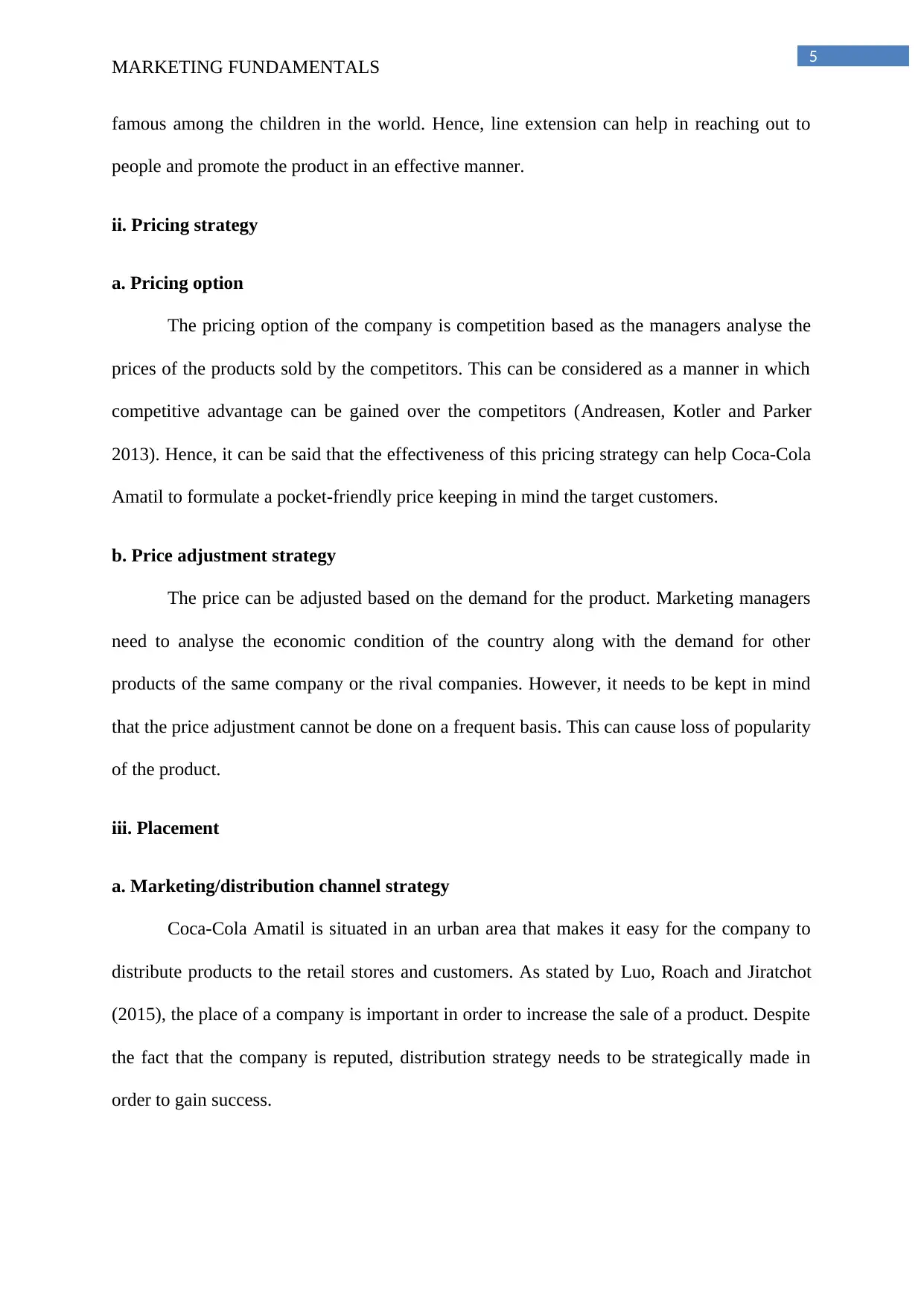
5
MARKETING FUNDAMENTALS
famous among the children in the world. Hence, line extension can help in reaching out to
people and promote the product in an effective manner.
ii. Pricing strategy
a. Pricing option
The pricing option of the company is competition based as the managers analyse the
prices of the products sold by the competitors. This can be considered as a manner in which
competitive advantage can be gained over the competitors (Andreasen, Kotler and Parker
2013). Hence, it can be said that the effectiveness of this pricing strategy can help Coca-Cola
Amatil to formulate a pocket-friendly price keeping in mind the target customers.
b. Price adjustment strategy
The price can be adjusted based on the demand for the product. Marketing managers
need to analyse the economic condition of the country along with the demand for other
products of the same company or the rival companies. However, it needs to be kept in mind
that the price adjustment cannot be done on a frequent basis. This can cause loss of popularity
of the product.
iii. Placement
a. Marketing/distribution channel strategy
Coca-Cola Amatil is situated in an urban area that makes it easy for the company to
distribute products to the retail stores and customers. As stated by Luo, Roach and Jiratchot
(2015), the place of a company is important in order to increase the sale of a product. Despite
the fact that the company is reputed, distribution strategy needs to be strategically made in
order to gain success.
MARKETING FUNDAMENTALS
famous among the children in the world. Hence, line extension can help in reaching out to
people and promote the product in an effective manner.
ii. Pricing strategy
a. Pricing option
The pricing option of the company is competition based as the managers analyse the
prices of the products sold by the competitors. This can be considered as a manner in which
competitive advantage can be gained over the competitors (Andreasen, Kotler and Parker
2013). Hence, it can be said that the effectiveness of this pricing strategy can help Coca-Cola
Amatil to formulate a pocket-friendly price keeping in mind the target customers.
b. Price adjustment strategy
The price can be adjusted based on the demand for the product. Marketing managers
need to analyse the economic condition of the country along with the demand for other
products of the same company or the rival companies. However, it needs to be kept in mind
that the price adjustment cannot be done on a frequent basis. This can cause loss of popularity
of the product.
iii. Placement
a. Marketing/distribution channel strategy
Coca-Cola Amatil is situated in an urban area that makes it easy for the company to
distribute products to the retail stores and customers. As stated by Luo, Roach and Jiratchot
(2015), the place of a company is important in order to increase the sale of a product. Despite
the fact that the company is reputed, distribution strategy needs to be strategically made in
order to gain success.
⊘ This is a preview!⊘
Do you want full access?
Subscribe today to unlock all pages.

Trusted by 1+ million students worldwide
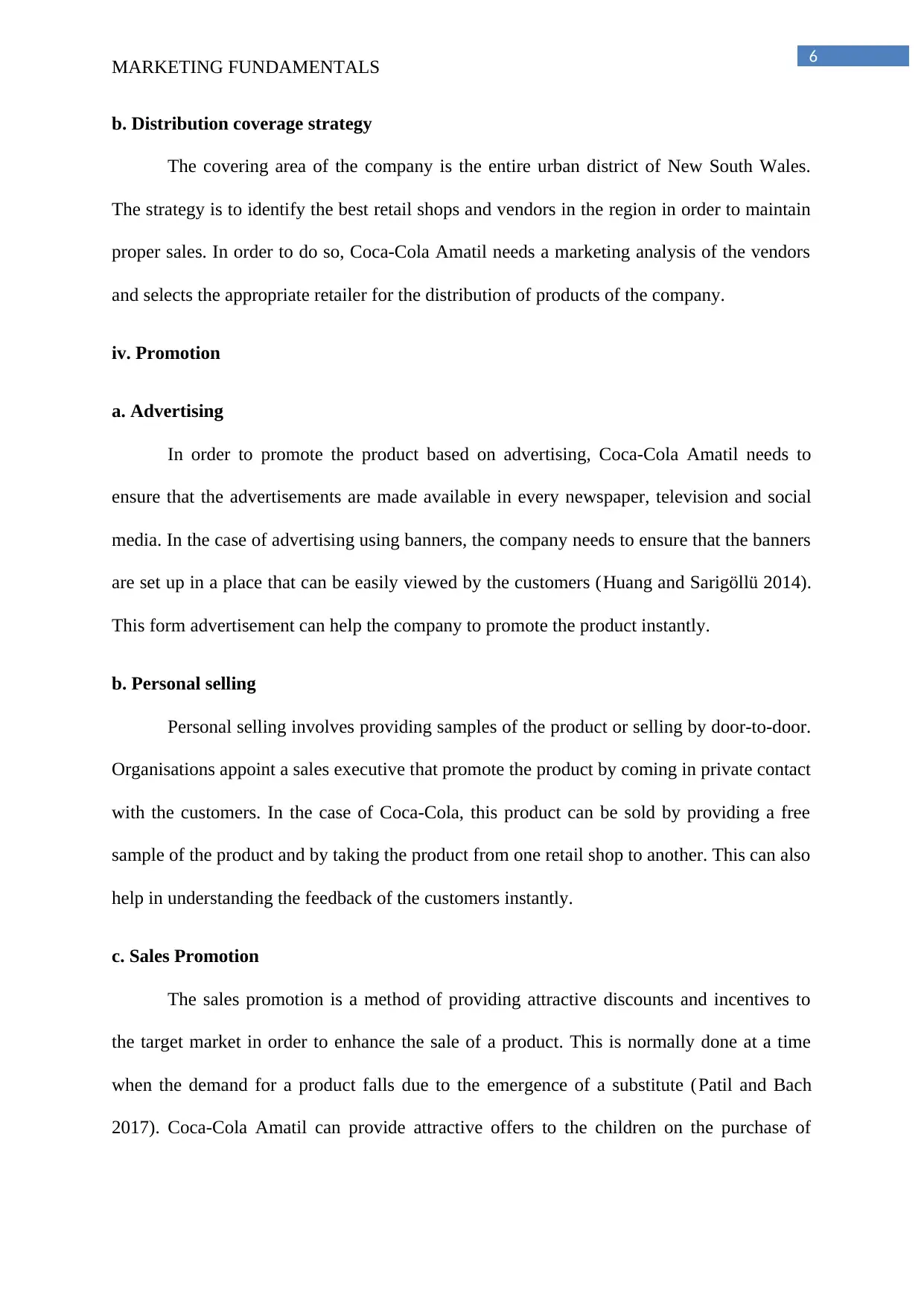
6
MARKETING FUNDAMENTALS
b. Distribution coverage strategy
The covering area of the company is the entire urban district of New South Wales.
The strategy is to identify the best retail shops and vendors in the region in order to maintain
proper sales. In order to do so, Coca-Cola Amatil needs a marketing analysis of the vendors
and selects the appropriate retailer for the distribution of products of the company.
iv. Promotion
a. Advertising
In order to promote the product based on advertising, Coca-Cola Amatil needs to
ensure that the advertisements are made available in every newspaper, television and social
media. In the case of advertising using banners, the company needs to ensure that the banners
are set up in a place that can be easily viewed by the customers (Huang and Sarigöllü 2014).
This form advertisement can help the company to promote the product instantly.
b. Personal selling
Personal selling involves providing samples of the product or selling by door-to-door.
Organisations appoint a sales executive that promote the product by coming in private contact
with the customers. In the case of Coca-Cola, this product can be sold by providing a free
sample of the product and by taking the product from one retail shop to another. This can also
help in understanding the feedback of the customers instantly.
c. Sales Promotion
The sales promotion is a method of providing attractive discounts and incentives to
the target market in order to enhance the sale of a product. This is normally done at a time
when the demand for a product falls due to the emergence of a substitute (Patil and Bach
2017). Coca-Cola Amatil can provide attractive offers to the children on the purchase of
MARKETING FUNDAMENTALS
b. Distribution coverage strategy
The covering area of the company is the entire urban district of New South Wales.
The strategy is to identify the best retail shops and vendors in the region in order to maintain
proper sales. In order to do so, Coca-Cola Amatil needs a marketing analysis of the vendors
and selects the appropriate retailer for the distribution of products of the company.
iv. Promotion
a. Advertising
In order to promote the product based on advertising, Coca-Cola Amatil needs to
ensure that the advertisements are made available in every newspaper, television and social
media. In the case of advertising using banners, the company needs to ensure that the banners
are set up in a place that can be easily viewed by the customers (Huang and Sarigöllü 2014).
This form advertisement can help the company to promote the product instantly.
b. Personal selling
Personal selling involves providing samples of the product or selling by door-to-door.
Organisations appoint a sales executive that promote the product by coming in private contact
with the customers. In the case of Coca-Cola, this product can be sold by providing a free
sample of the product and by taking the product from one retail shop to another. This can also
help in understanding the feedback of the customers instantly.
c. Sales Promotion
The sales promotion is a method of providing attractive discounts and incentives to
the target market in order to enhance the sale of a product. This is normally done at a time
when the demand for a product falls due to the emergence of a substitute (Patil and Bach
2017). Coca-Cola Amatil can provide attractive offers to the children on the purchase of
Paraphrase This Document
Need a fresh take? Get an instant paraphrase of this document with our AI Paraphraser
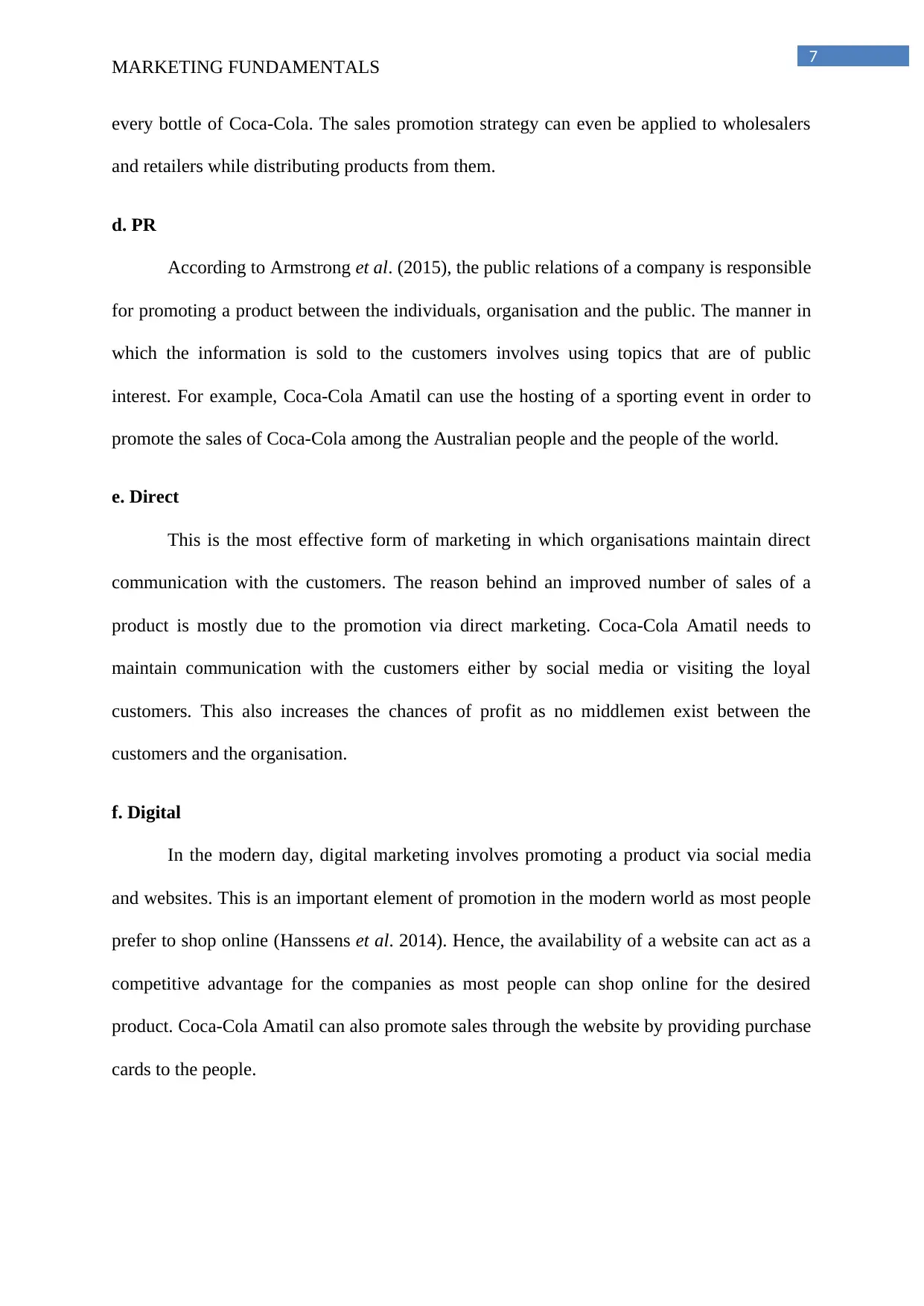
7
MARKETING FUNDAMENTALS
every bottle of Coca-Cola. The sales promotion strategy can even be applied to wholesalers
and retailers while distributing products from them.
d. PR
According to Armstrong et al. (2015), the public relations of a company is responsible
for promoting a product between the individuals, organisation and the public. The manner in
which the information is sold to the customers involves using topics that are of public
interest. For example, Coca-Cola Amatil can use the hosting of a sporting event in order to
promote the sales of Coca-Cola among the Australian people and the people of the world.
e. Direct
This is the most effective form of marketing in which organisations maintain direct
communication with the customers. The reason behind an improved number of sales of a
product is mostly due to the promotion via direct marketing. Coca-Cola Amatil needs to
maintain communication with the customers either by social media or visiting the loyal
customers. This also increases the chances of profit as no middlemen exist between the
customers and the organisation.
f. Digital
In the modern day, digital marketing involves promoting a product via social media
and websites. This is an important element of promotion in the modern world as most people
prefer to shop online (Hanssens et al. 2014). Hence, the availability of a website can act as a
competitive advantage for the companies as most people can shop online for the desired
product. Coca-Cola Amatil can also promote sales through the website by providing purchase
cards to the people.
MARKETING FUNDAMENTALS
every bottle of Coca-Cola. The sales promotion strategy can even be applied to wholesalers
and retailers while distributing products from them.
d. PR
According to Armstrong et al. (2015), the public relations of a company is responsible
for promoting a product between the individuals, organisation and the public. The manner in
which the information is sold to the customers involves using topics that are of public
interest. For example, Coca-Cola Amatil can use the hosting of a sporting event in order to
promote the sales of Coca-Cola among the Australian people and the people of the world.
e. Direct
This is the most effective form of marketing in which organisations maintain direct
communication with the customers. The reason behind an improved number of sales of a
product is mostly due to the promotion via direct marketing. Coca-Cola Amatil needs to
maintain communication with the customers either by social media or visiting the loyal
customers. This also increases the chances of profit as no middlemen exist between the
customers and the organisation.
f. Digital
In the modern day, digital marketing involves promoting a product via social media
and websites. This is an important element of promotion in the modern world as most people
prefer to shop online (Hanssens et al. 2014). Hence, the availability of a website can act as a
competitive advantage for the companies as most people can shop online for the desired
product. Coca-Cola Amatil can also promote sales through the website by providing purchase
cards to the people.
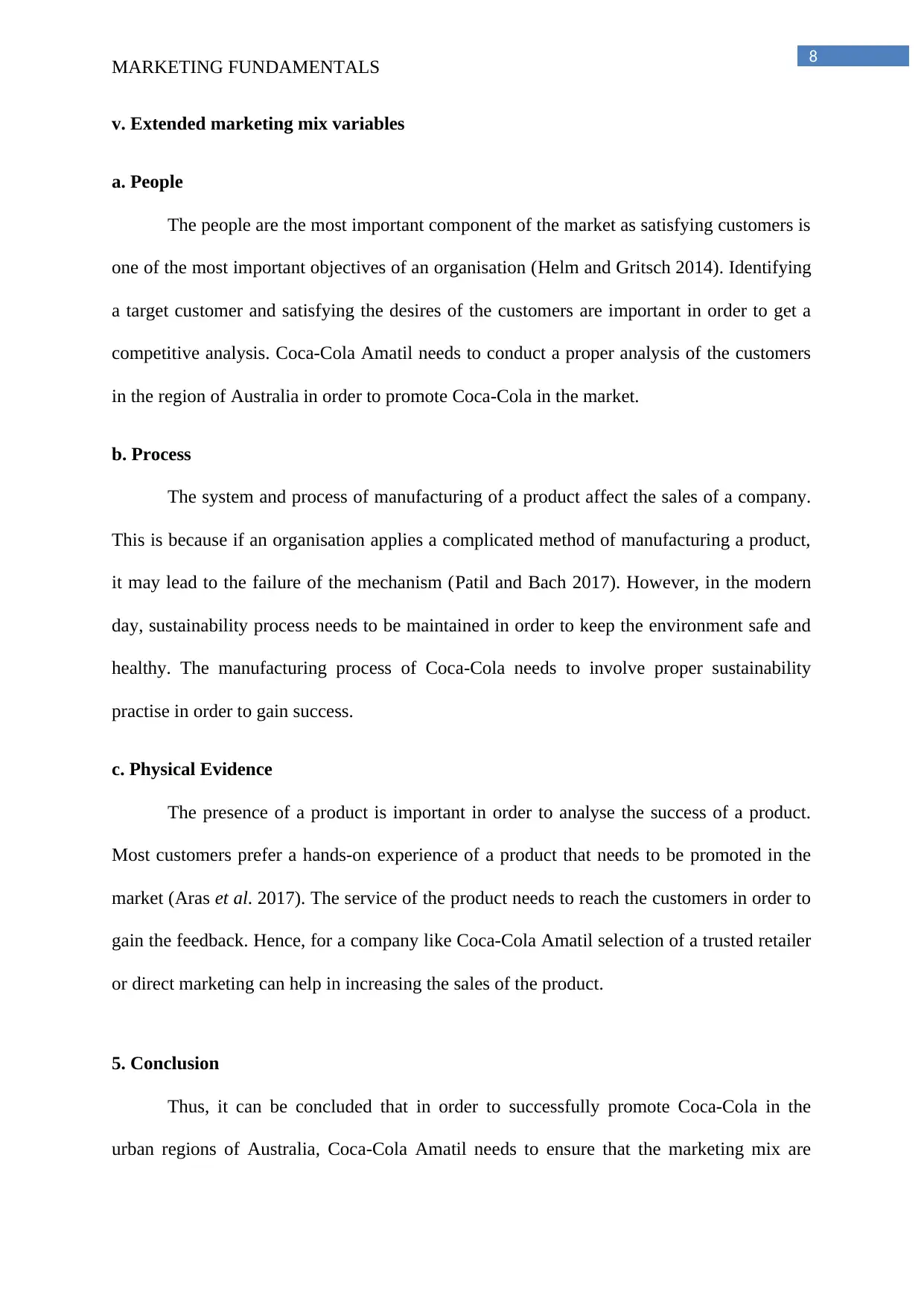
8
MARKETING FUNDAMENTALS
v. Extended marketing mix variables
a. People
The people are the most important component of the market as satisfying customers is
one of the most important objectives of an organisation (Helm and Gritsch 2014). Identifying
a target customer and satisfying the desires of the customers are important in order to get a
competitive analysis. Coca-Cola Amatil needs to conduct a proper analysis of the customers
in the region of Australia in order to promote Coca-Cola in the market.
b. Process
The system and process of manufacturing of a product affect the sales of a company.
This is because if an organisation applies a complicated method of manufacturing a product,
it may lead to the failure of the mechanism (Patil and Bach 2017). However, in the modern
day, sustainability process needs to be maintained in order to keep the environment safe and
healthy. The manufacturing process of Coca-Cola needs to involve proper sustainability
practise in order to gain success.
c. Physical Evidence
The presence of a product is important in order to analyse the success of a product.
Most customers prefer a hands-on experience of a product that needs to be promoted in the
market (Aras et al. 2017). The service of the product needs to reach the customers in order to
gain the feedback. Hence, for a company like Coca-Cola Amatil selection of a trusted retailer
or direct marketing can help in increasing the sales of the product.
5. Conclusion
Thus, it can be concluded that in order to successfully promote Coca-Cola in the
urban regions of Australia, Coca-Cola Amatil needs to ensure that the marketing mix are
MARKETING FUNDAMENTALS
v. Extended marketing mix variables
a. People
The people are the most important component of the market as satisfying customers is
one of the most important objectives of an organisation (Helm and Gritsch 2014). Identifying
a target customer and satisfying the desires of the customers are important in order to get a
competitive analysis. Coca-Cola Amatil needs to conduct a proper analysis of the customers
in the region of Australia in order to promote Coca-Cola in the market.
b. Process
The system and process of manufacturing of a product affect the sales of a company.
This is because if an organisation applies a complicated method of manufacturing a product,
it may lead to the failure of the mechanism (Patil and Bach 2017). However, in the modern
day, sustainability process needs to be maintained in order to keep the environment safe and
healthy. The manufacturing process of Coca-Cola needs to involve proper sustainability
practise in order to gain success.
c. Physical Evidence
The presence of a product is important in order to analyse the success of a product.
Most customers prefer a hands-on experience of a product that needs to be promoted in the
market (Aras et al. 2017). The service of the product needs to reach the customers in order to
gain the feedback. Hence, for a company like Coca-Cola Amatil selection of a trusted retailer
or direct marketing can help in increasing the sales of the product.
5. Conclusion
Thus, it can be concluded that in order to successfully promote Coca-Cola in the
urban regions of Australia, Coca-Cola Amatil needs to ensure that the marketing mix are
⊘ This is a preview!⊘
Do you want full access?
Subscribe today to unlock all pages.

Trusted by 1+ million students worldwide

9
MARKETING FUNDAMENTALS
followed in an effective manner. The fluctuation in price, selection of distribution place and
promotional strategy are important in order to gain a competitive advantage in the business
market.
MARKETING FUNDAMENTALS
followed in an effective manner. The fluctuation in price, selection of distribution place and
promotional strategy are important in order to gain a competitive advantage in the business
market.
Paraphrase This Document
Need a fresh take? Get an instant paraphrase of this document with our AI Paraphraser
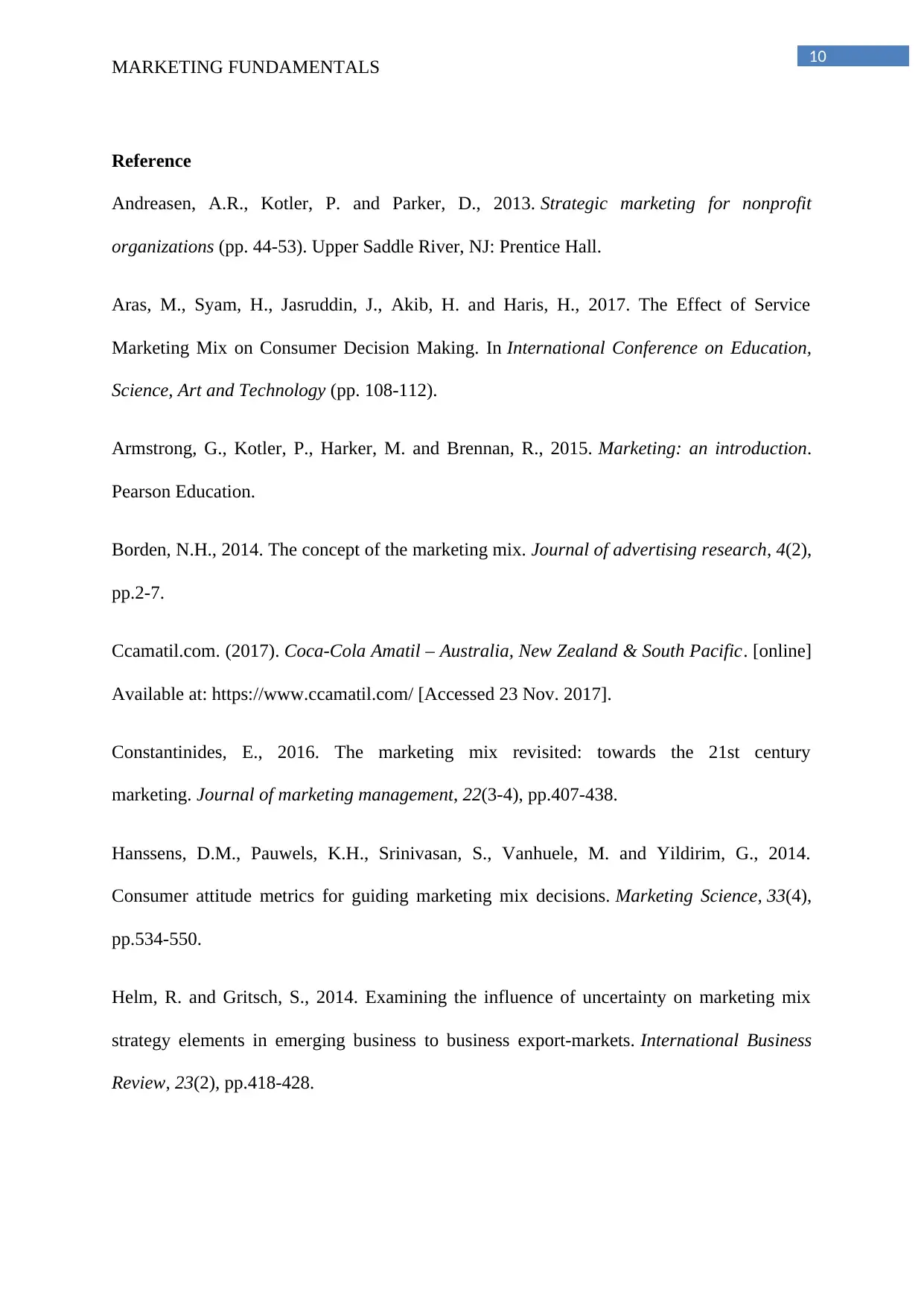
10
MARKETING FUNDAMENTALS
Reference
Andreasen, A.R., Kotler, P. and Parker, D., 2013. Strategic marketing for nonprofit
organizations (pp. 44-53). Upper Saddle River, NJ: Prentice Hall.
Aras, M., Syam, H., Jasruddin, J., Akib, H. and Haris, H., 2017. The Effect of Service
Marketing Mix on Consumer Decision Making. In International Conference on Education,
Science, Art and Technology (pp. 108-112).
Armstrong, G., Kotler, P., Harker, M. and Brennan, R., 2015. Marketing: an introduction.
Pearson Education.
Borden, N.H., 2014. The concept of the marketing mix. Journal of advertising research, 4(2),
pp.2-7.
Ccamatil.com. (2017). Coca-Cola Amatil – Australia, New Zealand & South Pacific. [online]
Available at: https://www.ccamatil.com/ [Accessed 23 Nov. 2017].
Constantinides, E., 2016. The marketing mix revisited: towards the 21st century
marketing. Journal of marketing management, 22(3-4), pp.407-438.
Hanssens, D.M., Pauwels, K.H., Srinivasan, S., Vanhuele, M. and Yildirim, G., 2014.
Consumer attitude metrics for guiding marketing mix decisions. Marketing Science, 33(4),
pp.534-550.
Helm, R. and Gritsch, S., 2014. Examining the influence of uncertainty on marketing mix
strategy elements in emerging business to business export-markets. International Business
Review, 23(2), pp.418-428.
MARKETING FUNDAMENTALS
Reference
Andreasen, A.R., Kotler, P. and Parker, D., 2013. Strategic marketing for nonprofit
organizations (pp. 44-53). Upper Saddle River, NJ: Prentice Hall.
Aras, M., Syam, H., Jasruddin, J., Akib, H. and Haris, H., 2017. The Effect of Service
Marketing Mix on Consumer Decision Making. In International Conference on Education,
Science, Art and Technology (pp. 108-112).
Armstrong, G., Kotler, P., Harker, M. and Brennan, R., 2015. Marketing: an introduction.
Pearson Education.
Borden, N.H., 2014. The concept of the marketing mix. Journal of advertising research, 4(2),
pp.2-7.
Ccamatil.com. (2017). Coca-Cola Amatil – Australia, New Zealand & South Pacific. [online]
Available at: https://www.ccamatil.com/ [Accessed 23 Nov. 2017].
Constantinides, E., 2016. The marketing mix revisited: towards the 21st century
marketing. Journal of marketing management, 22(3-4), pp.407-438.
Hanssens, D.M., Pauwels, K.H., Srinivasan, S., Vanhuele, M. and Yildirim, G., 2014.
Consumer attitude metrics for guiding marketing mix decisions. Marketing Science, 33(4),
pp.534-550.
Helm, R. and Gritsch, S., 2014. Examining the influence of uncertainty on marketing mix
strategy elements in emerging business to business export-markets. International Business
Review, 23(2), pp.418-428.
1 out of 11
Related Documents
Your All-in-One AI-Powered Toolkit for Academic Success.
+13062052269
info@desklib.com
Available 24*7 on WhatsApp / Email
![[object Object]](/_next/static/media/star-bottom.7253800d.svg)
Unlock your academic potential
Copyright © 2020–2025 A2Z Services. All Rights Reserved. Developed and managed by ZUCOL.





